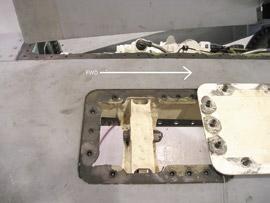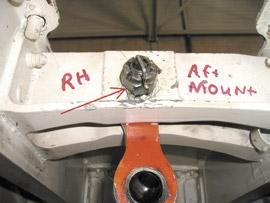
4 minute read
To Reverse or Not To Reverse
By Emmanuel Basye
This area is where bolts and nuts often are assembled incorrectly.
Advertisement
We just had completed a modification on an FA18F ahead of schedule and was ready to turn it over to the squadron. During the turnover, the squadron prepared to tow the aircraft and then moved it outside the hangar. Once it was out of the way, another aircraft was moved inside the hangar to take its place, and the whole process started all over again.
After this exchange, I normally do a walk-around to check the doors, fasteners, and panels. If any are missing, I make a note. Part of our job is to remove both engines to do the required modification. The supervisor briefed the team, and off we went. After removing the door and disconnecting fuel lines, electrical cables, P-duct, bleed-air line, and PT shaft, we were ready to roll. I did another check and then notifed our QA for a final inspection, who then gave me the OK when everything was clear. Our team then started to set up the ETU stand under the engine. When the engine removal was completed, we moved one engine to a 3,000 engine trailer and secured the other to an engine stand. This particular evolution went smoothly, so we took a break.
After getting back to work, I went on top of the aircraft to inspect an area that required another door removal. I then walked over a few steps to the aft engine-mount location to inspect the expandable pin and to verify the locking mechanism function and condition. Though this inspection isn’t part of the job
The bolts and nuts clearly are facing the wrong way.


contract, we do it as a courtesy. If any discrepancies are found, we notify the squadron.
After finding the right hand expandable pin in good condition, I looked at the left hand pin and it looked good, too. However, my brain was telling me that something was amiss. I then stood up and looked at the right and left side shear-bolt nuts. As I glanced at the two sides, I wondered why the bolts were facing in opposite directions. Realizing one of them was installed in reverse, I went to another aircraft that recently had been through the same procedure to compare the bolts. Sure enough, the right hand shear bolt was installed the wrong way. Just to make sure and to verify the proper installation, I also looked in the IETMS. Sure enough, the bolts were not installed correctly.
I then notified our shop’s lead man, QA, and supervisor. Our lead man took digital photos to document the problem. While he was doing that, our QA looked at the aft mount and then went back to the office to notify the squadron. Later, a squadron QAR came by, looked at the situation, and then left. Beforehand, though, he told us that he would notify his maintenance control for corrective action.
The next morning, as I was setting up my tools behind the aircraft, I looked up and noticed the shear bolt was re-positioned and installed the right way. However, while looking at the bolt and nut from the ground floor, I realized something else was wrong. I moved the
This view shows correct order.

ladder underneath, and it only took seconds before I realized the aircraft now needed more maintenance.
The flat washer was installed backward—again! I notified the same people, and our QA also called the squadron. The work was back to square one. I’m sure you have an idea how the mod team, as well as the squadron personnel, reacted to this problem.
What can you take from this article? If you forget to look in the technical manual, IETMS or whatever, and just go do the job without a reference, you’re asking for trouble. When the right-hand shear bolt in this case was found installed in reverse, maintainers should have looked at other possible problems. Perhaps the person who was supposed to inspect the completed installation (or corrective action) at that time wasn’t there. Perhaps the inspector didn’t notice the washer was installed incorrectly. Perhaps the technician forgot to ask to have the corrective action inspected.
Either way, time, effort, and manpower were wasted. I’m sure the supervisor and peers were shaking their heads in disbelief and dismay.
When in doubt about a job, ask questions, or check the IETMS or technical manual before you do a corrective action.
Aviation maintenance can be rewarding for those who enjoy working on any type of aircraft, but it can be unforgiving or deadly when simple and minor maintenance is done incorrectly.
Mr. Basye is a maintainer on a mod team at NAS Lemoore.

The flat washer is installed incorrectly.


A different view of the incorrect installation.

Illustrated parts breakdown of the correct configurations.










